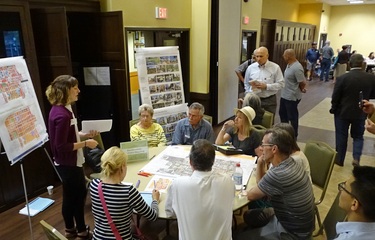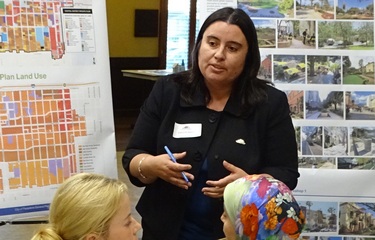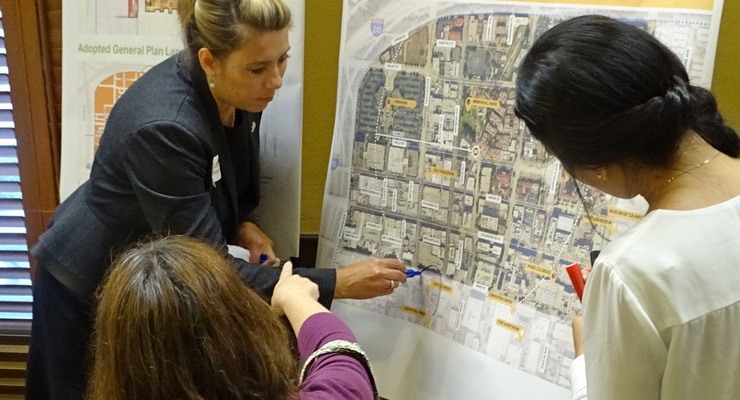With suggestions ranging from the grand to the mundane, nearly a hundred Pasadena residents filled the community room at the Pasadena Senior Center Tuesday for the first of three workshops to develop the new specific plan for Pasadena’s Central Area, one of eight targeted neighborhood blueprints being developed to implement the City’s overall General Plan.
Specific Plans are, as the name implies, “specific” neighborhood-focused plans which aim to reflect the unique qualities of Pasadena’s distinct neighborhoods. The City has eschewed a one-plan-fits-all approach in favor of smaller, tighter, focused planning to retain each area’s flavor.
“We are very early in this process,” said Senior Planner and Project Lead Anita Cerna. “This is just the first of three we will have for this district alone.”
 According to the City’s presentation, the goal of the first workshops is to “Refine the General Plan’s vision, goals, and policies as they apply to each unique Specific Plan area.”
According to the City’s presentation, the goal of the first workshops is to “Refine the General Plan’s vision, goals, and policies as they apply to each unique Specific Plan area.”
“I think they’re doing a good process here,” said Councilmember Andy Wilson. “I recognize many of the people here, and they are very thoughtful people who want to see the City get it right.”
Eight City Specific Plans are being developed over a three-year period — one each for the Central District, East Colorado, East Pasadena, Fair Oaks/Orange Grove, Lamanda Park, Lincoln Avenue, North Lake, and South Fair Oaks neighborhoods. Cerna anticipates that the eight draft plans will move to the City Council for final approval in 2021.
The City’s last General Plan update was in 2015.
“All these plans affect the whole city overall,” said Cerna. “For example, if we create more density in one area, we need to make sure that there are more services. It’s a challenge to create consensus for these plans. It’s all about how buildings relate to the streets they’re on.”
All of the eight plans are to be steered by the City Planning Department’s “Guiding Principles”:
- Target Growth to enhance quality of life
- Preserve historic resources,
- Promote economic vitality
- Balance all areas of sustainability
- Make car-free circulation possible
- Be a leader in the region
- Welcome community participation
- Commit to diverse education
According to the City website, www.ourpasadena.org, the Central District is the City’s “urban core and primary civic, business, financial, retail, entertainment and cultural center with direct access to the Del Mar, Memorial Park, and Lake Metro Gold Line stations.”
The area includes Old Pasadena, the Civic Center, the Pasadena Playhouse, and the South Lake District.
 “The General Plan envisions building upon the Central District’s existing strength as a walkable, vibrant downtown; fostering a varied mix of uses, including retail, restaurants, and entertainment, higher density residential, office, and open spaces that are connected by multiple modes of transportation,” states the website.
“The General Plan envisions building upon the Central District’s existing strength as a walkable, vibrant downtown; fostering a varied mix of uses, including retail, restaurants, and entertainment, higher density residential, office, and open spaces that are connected by multiple modes of transportation,” states the website.
While previous neighborhood meetings that included mobility and transportation as part of their elements, pitted cycling activists against those who would eliminate bike lanes, the workshop and presentations Tuesday centered on group discussions and comments, few of which mentioned bike lanes.
In addition to the Central Specific Plan, residents also commented and made suggestions in small groups regarding various neighborhoods within those plan areas.
Architect David Wolf, for example, lamented what he termed the “dead zone,” a large block of buildings at the eastern end of Old Pasadena at the Arroyo Seco Parkway. The area includes the oft-criticized black “Darth Vader” building which houses a Steinway Piano store.
“We need to be careful of fragmentation,” said Wolf, who feels that the back building creates a psychological barrier to Old Pasadena to the west.
“We need to re-synthesize that building,” said Wolf.
Additional suggestions ranged from not allowing motorized scooters in Old Pasadena, and moving bike lanes to Holly Street. Still others criticized the permanent awnings on the new-ish Great Maple restaurant at Paseo Pasadena.
Another resident discussed the importance of “viewscapes,” noting, for example, that Castle Green’s towers can be seen from the front of City Hall.
“Castle Green sets the tone for that neighborhood,” agreed Jonathan Edewards, president of the Downtown Pasadena Neighborhood Association.
In the Playhouse District, other residents criticized the lack of green space in and around El Molino, while still others saw an opportunity to increase the number of “scrambled” crosswalks, which have been successful in the Old Pasadena neighborhood.
Residents suggested more free parking for the area, as well as more traffic-calming methods.
Centennial Plaza and the historic YWCA building, which was removed from consideration as a boutique hotel by the City Council last year, was also suggested as an ideal place for City offices by resident and Civic Center Task Force member Claire Bogaard.
“I’m not convinced it can be used by the City,” she said, “but that would be my first choice.”

















